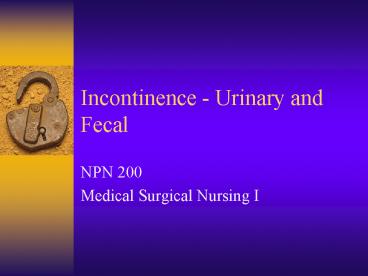Incontinence Urinary and Fecal - PowerPoint PPT Presentation
1 / 11
Title:
Incontinence Urinary and Fecal
Description:
Usually R/T colorectal disease/may have blood or mucus. Overflow ... Provide for regular, scheduled bowel emptying (usually 30 min after eating) ... – PowerPoint PPT presentation
Number of Views:280
Avg rating:3.0/5.0
Title: Incontinence Urinary and Fecal
1
Incontinence - Urinary and Fecal
- NPN 200
- Medical Surgical Nursing I
2
Urinary Incontinence
- USA- 13 million (85 women)
- Stress incontinence - most common type
- Loss of urine when, sneezing, jogging or lifting
- Common after childbirth and menopause
- Urge incontinence
- Inability to suppress the urge to void, may be
caused by infection, stroke,, etc. - Overflow incontinence
- Occurs when the muscles in the bladder do not
contract and the bladder becomes distended over
its capacity - Functional incontinence lack of awareness
3
Causes of Incontinence
- Medications - CNS depressants, diuretics,
multiple medications - Disease CVAs, arthritis, Parkinsons
- Depression decreases energy to remain
continent, decreasing self worth decreases desire
to remain continent - Inadequate resources glasses, canes, may be
afraid to ambulate, products to manage are
costly, and no one available to help to bathroom
4
Assessment
- Questions Do you leak urine when you cough or
sneeze, on the way to the bathroom, or do you
wear pads, tissue or use cloths to catch leaking
urine? - Have patient describe the pattern and volume of
urine, and any related symptoms - May observe a stale urine odor
- Assess for distention, may need post void
residual, have patient cough while wearing a pad - Clean catch urine, post void residual CBC
- Voiding cystogram, cystoscope , cystometry,
uroflowmetry
5
Medical Treatment
- Surgery to improve the tone of the sphincter,
artificial sphincters, repair cystocele (anterior
vaginal repair), retropubic suspension,
pubovaginal sling, or other means such as
collagen injections - Non-surgical management
- Drug interventions
- Behavioral interventions
- Intermittent catheterization
- Indwelling catheter
- Penile clamps
- Pelvic organ support devices (pessary)
6
Interventions
- Urinary bladder training
- Improves bladder function by increasing the
bladders ability to hold urine and the clients
ability to hold urine and suppress urination - Urinary habit training
- Establishes a predictable pattern of bladder
emptying to prevent incontinence for patients who
have urge, stress, or functional incontinence - Urinary catheterization intermittent regular
periodic use of a catheter to empty bladder - Teach use of incontinent products
7
Potential Complications of Urinary Incontinence
- Impaired skin integrity
- Risk for infection
- Social isolation
- Low self esteem
8
Fecal Incontinence
- Less common
- Caused by trauma, sphincter dysfunction,
childbirth, Crohns disease, or diabetic
neuropathy - Severe diarrhea may cause temporary incontinence
- May also be R/T impaction
9
Fecal Incontinence
- Types
- Symptomatic
- Usually R/T colorectal disease/may have blood or
mucus - Overflow
- Caused by constipation, where the feces fills the
entire colon - Patient passes semi-formed stool frequently
- Can be seen in patients with long term laxative
use - Treat by cleansing over 7-10 days, then work on
constipation - Neurogenic
- Patients who do not voluntarily delay defecation
- Usually with dementia
- Anorectal
- Nerve damage which weakens muscles in the pelvic
floor - Have several incontinent stools per day
10
Nursing Assessment
- What is the problem?
- Identify bowel patterns
- Identify characteristics
- Color
- Clarity
- Consistency
- Past problems
- Perform physical exam
- Inspect rectal area
11
Treatment/Interventions
- Provide for regular, scheduled bowel emptying
(usually 30 min after eating) - Give ordered laxatives or enemas
- Teach dietary and fluid requirements
- Encourage ambulation or activity as tolerated
- Cleanse and protect perineum after each BM
- Use depends or fecal pouches when necessary
- Always encourage patient and be prompt in
attending to needs































